Working a 12-hour nursing shift can feel like running a marathon — your feet swell, your legs ache, and by the end of the day, you’re ready to collapse. Long hours on your feet are tough, and let’s be honest, not all socks are made for this kind of endurance.
The good news? The right pair of compression socks for nurses can make a world of difference. They improve circulation, reduce fatigue, and help you stay comfortable from your first patient check to the end-of-shift paperwork.
In this guide, we’ve reviewed the 10 best compression socks for nurses to help you tackle those long shifts with ease. From supportive designs to breathable fabrics, you’ll find the perfect pair to keep your legs happy all day.
Best Overall Pick
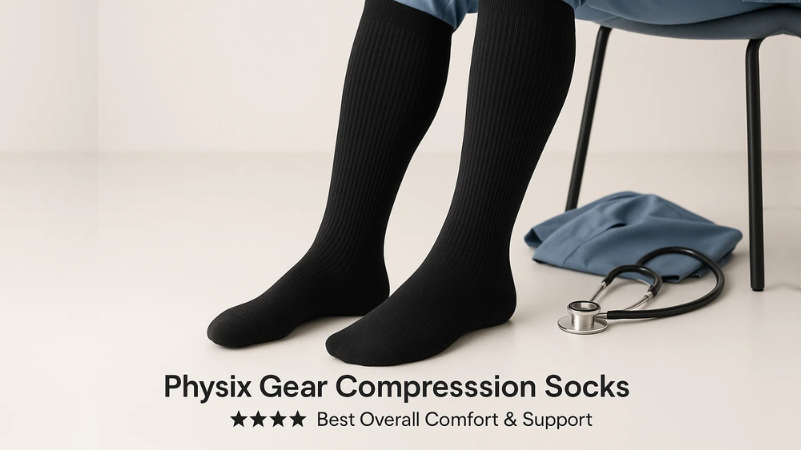
Best For: With a 20-30 mmHg graduated compression, these socks improve circulation, reduce swelling, and keep your legs energized even during the toughest 12-hour shifts.
Reason: These socks are made from high-quality, breathable materials that wick moisture away, keeping your feet dry and comfy throughout the day.
A Quick Preview of the Best Compression Socks for Nurses
Finding the right compression socks can be overwhelming with so many options on the market. To make your decision easier, we’ve put together a quick comparison of the top 10 compression socks for nurses.
Image | Name | Specialities | Price |
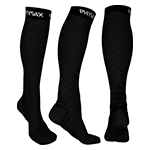 | Physix Gear Compression |
| |
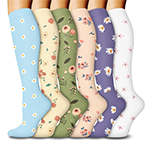 | FuelMeFoot 6 Pairs Compression |
| |
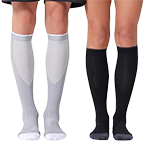 | FITRELL 3 Pairs Compression |
| |
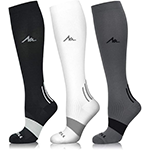 | NEWZILL Medical Compression |
| |
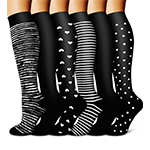 | BLUEENJOY Copper Compression |
| |
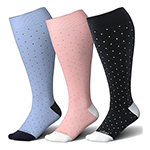 | LEVSOX Wide Calf Compression |
| |
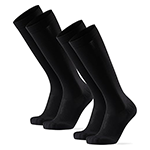 | DANISH ENDURANCE Graduated Compression |
| |
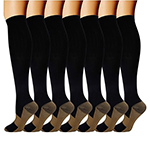 | Double Couple 7 Pairs Copper Compression |
| |
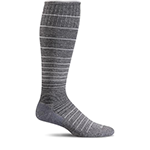 | Sockwell Women's Circulator Moderate Graduated Compression |
| |
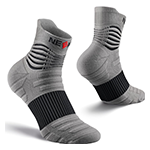 | NEENCA Medical Compression |
|
Understanding the Best Compression Socks for Nurses
Being a nurse means long hours on your feet, often stretching to 12-hour shifts or more. By the end of the day, swollen legs, achy calves, and tired feet can feel unavoidable.
That’s where compression socks designed for nurses come in — they’re not just any socks; they’re a tool to keep you comfortable, energized, and performing your best.
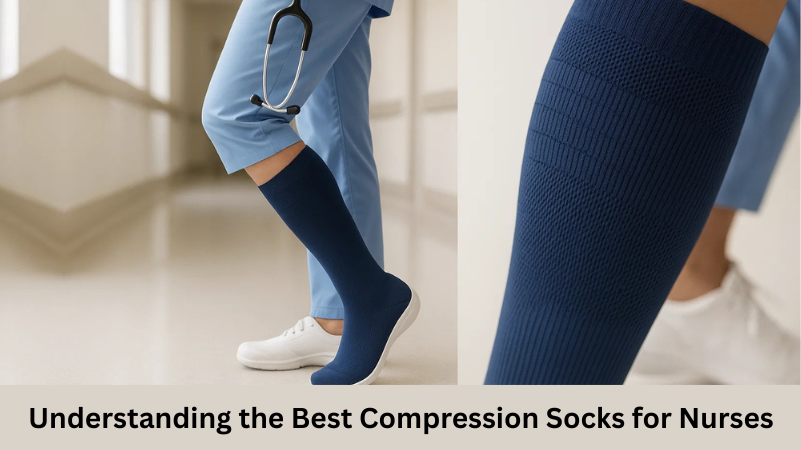
What It Does for Your Legs
The key to an effective pair lies in graduated compression. This means the sock applies the strongest pressure at the ankle, gradually easing up toward the calf. This gentle squeeze encourages proper blood flow, reduces leg fatigue, and helps prevent swelling.
In a fast-paced hospital environment, this support can make a huge difference in how your legs feel during and after a shift.
Material Matters: Breathable and Durable Socks
Material choice is another crucial factor. Nurses often sweat during long shifts, so socks made from breathable, moisture-wicking fabrics help keep feet dry and prevent discomfort or odor.
Reinforced heels and toes add durability, so your socks can withstand repeated wear and frequent washing — essential for a wardrobe that gets daily use.
Fit and Comfort: Finding the Perfect Pair
Fit and comfort shouldn’t be overlooked. The best compression socks for nurses hug the leg snugly without sliding down or bunching up.
Many designs come in unisex sizes or wide calf options, accommodating different leg shapes comfortably. Some even include extra padding for enhanced comfort during long walks or standing periods.
Style and Usability: More Than Just Function
Style and usability matter more than you might think. Nurses want socks that not only support their legs but also look professional or fun, depending on hospital dress codes.
With options ranging from neutral colors to patterned designs, it’s easy to find socks that match your uniform while still giving your legs the care they need.
Why Quality Socks Are Essential
In short, the best compression socks for nurses combine medical-grade support, superior comfort, and practical design. They reduce swelling, improve circulation, and make long shifts less exhausting — all while being durable and easy to wear.
Investing in a quality pair is not just a comfort choice; it’s a health-conscious decision for anyone on their feet all day.
Top 10 Best Compression Socks for Nurses 2025
Finding the perfect pair of compression socks can make all the difference during long, demanding hospital shifts. Now nurses have more advanced and comfortable options than ever.
Below, we’ve rounded up the top 10 best compression socks for nurses that deliver unbeatable comfort, circulation support, and durability for those who spend hours on their feet.
1. Physix Gear Compression Socks 20-30 mmHg
Rating: 9.5/10The Physix Gear Compression Socks offer a snug yet comfortable fit, making them ideal for long shifts. Crafted from a blend of nylon and spandex, they provide 20-30 mmHg graduated compression, which is effective in reducing leg fatigue and swelling.
Users have reported that the socks stay in place throughout the day without slipping or bunching, ensuring consistent support.
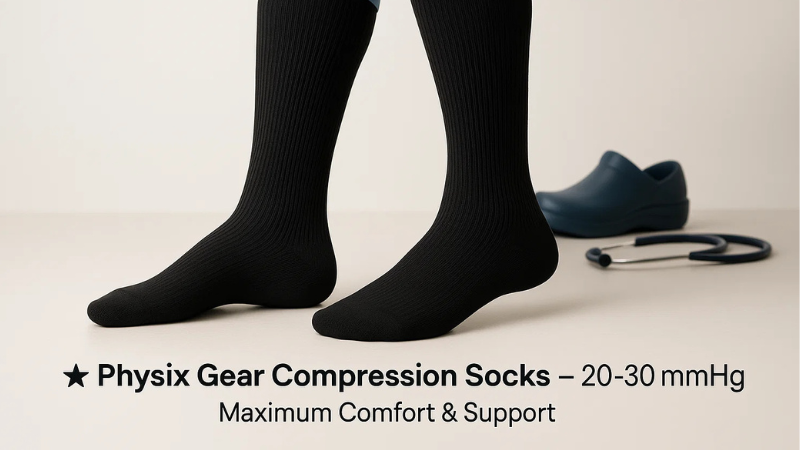
- Compression Level: 20-30 mmHg for firm support
- Material: Blend of nylon and spandex
- Reinforced Areas: Toe and heel for added durability
- Moisture-Wicking: Keeps feet dry and comfortable
- Sizes: Available in multiple sizes to fit various foot shapes
These socks are designed to withstand the demands of daily wear. The reinforced toe and heel areas add durability, while the moisture-wicking fabric keeps feet dry and comfortable. Available in various sizes, they cater to a wide range of users, ensuring that every nurse can find a suitable fit.
Despite their firm compression, many users find them easy to put on and take off. The socks maintain their elasticity and shape even after multiple washes, making them a reliable choice for long-term use.
- Provides significant relief from leg fatigue and swelling
- Durable construction suitable for daily wear
- Moisture-wicking fabric enhances comfort
- Available in a range of sizes for a better fit
- The firm compression may be challenging for first-time users
- Limited color options may not suit all preferences
Sometimes you feel like you need nursing shoes too, if it happens, check out:
2. FuelMeFoot 6 Pairs Compression Socks (15-20mmHg)
Rating: 9/10The FuelMeFoot Compression Socks are designed to provide moderate support with a 15-20mmHg graduated compression. This level of compression is ideal for nurses who experience mild leg fatigue or swelling. The socks are made from a blend of nylon and spandex.
These socks are built to withstand the demands of daily wear. The reinforced toe and heel areas add durability, while the moisture-wicking fabric keeps feet dry and comfortable. Available in a variety of colors and patterns, they cater to different personal styles.
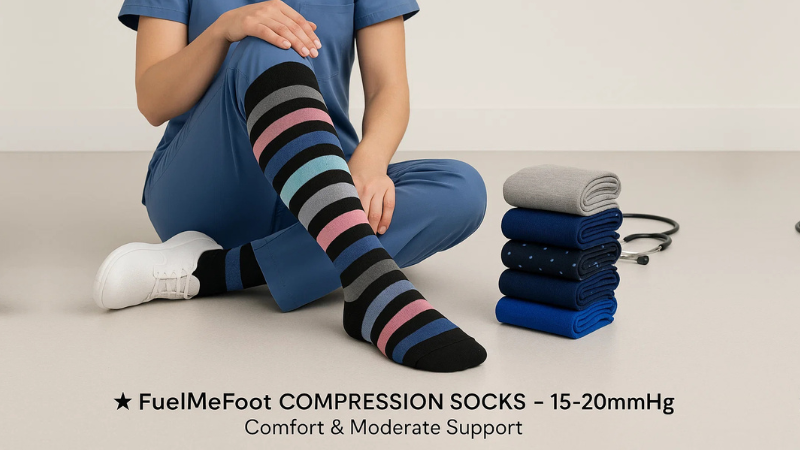
- Compression Level: 15-20 mmHg for moderate support
- Material: Blend of nylon and spandex
- Reinforced Areas: Toe and heel for added durability
- Moisture-Wicking: Keeps feet dry and comfortable
- Design Options: Available in various colors and patterns
Despite their moderate compression, many users find them easy to put on and take off. The socks maintain their elasticity and shape even after multiple washes, making them a reliable choice for long-term use.
- Provides relief from mild leg fatigue and swelling
- Durable construction suitable for daily wear
- Moisture-wicking fabric enhances comfort
- Wide range of design options to suit personal style
- Moderate compression may not be sufficient for those with severe leg issues
- Limited size options may not fit all users
3. FITRELL 3 Pairs Compression Socks for Women and Men 20-30mmHg
Rating: 9.3/10The FITRELL Compression Socks offer medical-grade 20-30mmHg graduated compression, making them ideal for nurses working long 12-hour shifts. They effectively reduce leg fatigue, swelling, and discomfort, ensuring your feet and calves feel energized throughout your shift.
Made from a breathable, moisture-wicking fabric, these socks keep your feet dry and comfortable even during the busiest hospital hours.
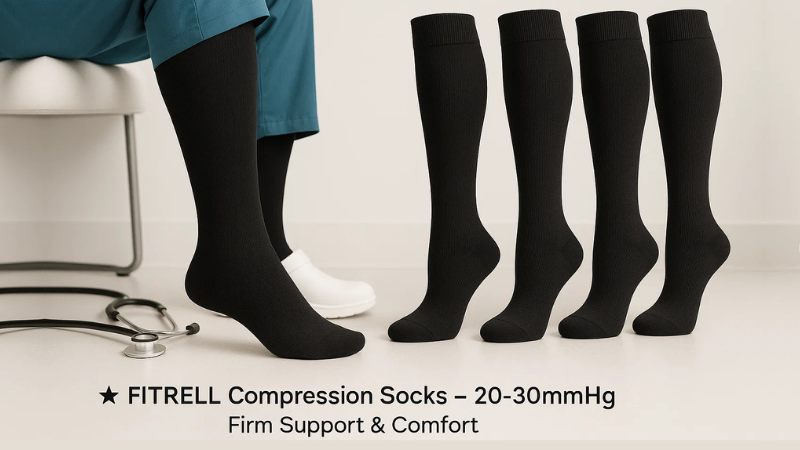
- Compression Level: 20-30 mmHg for firm support
- Material: Breathable, moisture-wicking fabric
- Reinforced Areas: Toe and heel for durability
- Sizing: Unisex, multiple sizes available
- Pack: 3 pairs per set
Durability is key for nurses who rely on their socks daily, and FITRELL delivers. Reinforced heel and toe areas prevent wear and tear, while the elastic cuffs keep the socks snug without slipping. The unisex sizing ensures a comfortable fit for various leg shapes, and the design is simple yet professional for workplace use.
Despite being firm compression socks, FITRELL makes putting them on easy. They maintain their shape and compression even after repeated washing. Whether you’re walking hospital corridors or standing for hours, these socks provide reliable support that lasts.
- Firm compression reduces swelling and fatigue
- Durable and long-lasting material
- Breathable and moisture-wicking
- Unisex sizing accommodates a variety of leg shapes
- May feel tight for first-time compression sock users
- Limited color options
Besides selecting the best compression socks for nurses, learn how to clean nursing shoes.
4. NEWZILL Medical Compression Socks 20-30 mmHg
Rating: 9.2/10The NEWZILL Medical Compression Socks provide firm 20-30 mmHg graduated compression, making them ideal for nurses enduring long shifts. Crafted from a blend of 65% polyamide and 35% spandex, these socks offer a snug yet comfortable fit that stays in place throughout the day.
The moisture-wicking fabric ensures your feet remain dry and comfortable, even during the busiest hospital hours.
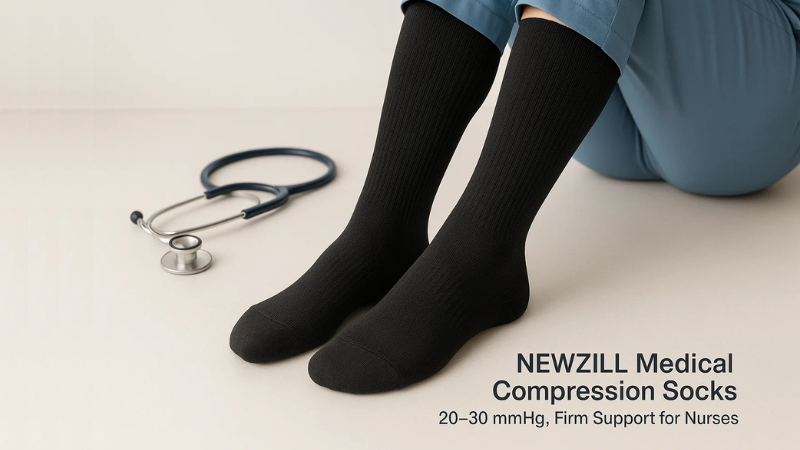
- Compression Level: 20-30 mmHg for firm support
- Material: 65% polyamide, 35% spandex; latex-free
- Reinforced Areas: Toe and heel for added durability
- Moisture-Wicking: Keeps feet dry and comfortable
- Design Options: Available in various colors and patterns
These socks are designed to withstand the rigors of daily wear. The reinforced toe and heel areas add durability, while the latex-free material caters to those with sensitivities. Available in various colors and patterns, they allow nurses to express their personal style while maintaining professionalism.
Despite their firm compression, many users find them easy to put on and take off. The socks maintain their elasticity and shape even after multiple washes, making them a reliable choice for long-term use.
- Provides significant relief from leg fatigue and swelling
- Durable construction suitable for daily wear
- Moisture-wicking fabric enhances comfort
- Available in a range of sizes and designs
- The firm compression may be challenging for first-time users
- Limited size options may not fit all users
5. BLUEENJOY Copper Compression Socks for Women & Men
Rating: 9/10The BLUEENJOY Copper Compression Socks provide 20-30 mmHg graduated compression, offering solid support for nurses on long shifts.
The copper-infused fibers help reduce odor and keep your feet feeling fresh, even during extended hospital hours. The socks hug your calves snugly without slipping, helping to alleviate swelling and leg fatigue.
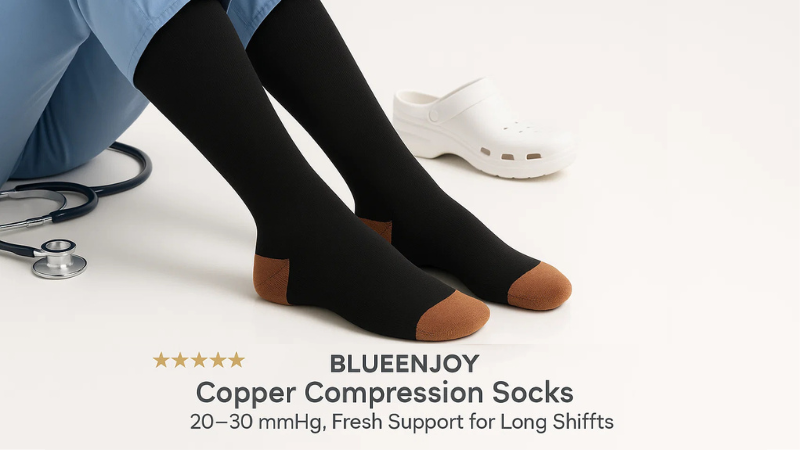
- Compression Level: 20-30 mmHg for firm support
- Material: Copper-infused, breathable fabric
- Reinforced Areas: Toe and heel for durability
- Odor Control: Copper fibers reduce odor
- Sizing: Unisex, multiple sizes available
These socks are built to last, with reinforced heel and toe areas that prevent wear and tear. They are breathable and lightweight, allowing your feet to stay comfortable throughout the day. The copper infusion adds an extra layer of antimicrobial protection, which is particularly useful in medical environments.
Despite their firm compression, the BLUEENJOY socks are easy to put on and maintain their shape after multiple washes. They are unisex and available in a variety of sizes, ensuring a comfortable fit for most users.
- Firm compression reduces leg fatigue and swelling
- Copper infusion helps control odor
- Durable and breathable fabric
- Unisex sizing accommodates most users
- Firm compression may be too tight for beginners
- Limited color options
6. LEVSOX Wide Calf Compression Socks for Women & Men
Rating: 8.8/10These LEVSOX wide-calf socks are tailored specifically for users who need extra room in the calf area—perfect for nurses with larger calves or those who wear them under scrubs for 12-hour shifts.
The 15-20 mmHg compression offers a moderate level of support that can ease fatigue and swelling without feeling overly tight. According to the brand, the wide-calf design ensures a non-binding, more comfortable fit.
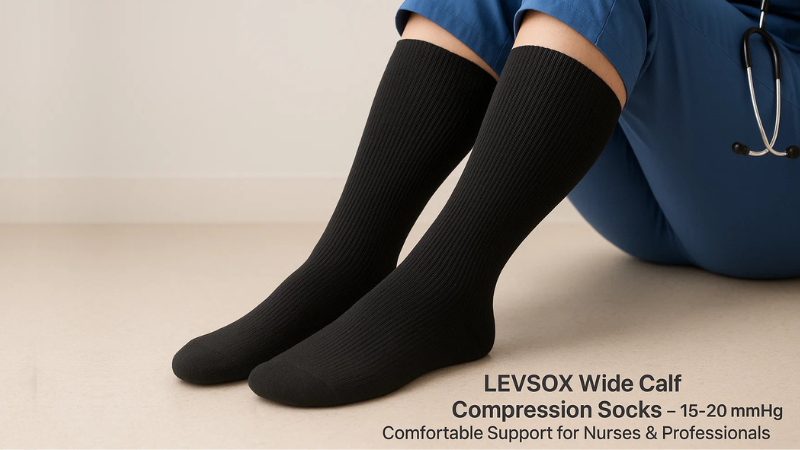
- Compression Level: 15-20 mmHg (moderate support)
- Designed for wide calves / plus-size users
- Material: bamboo/viscose blends or thick cotton blends (brand dependent)
- Non-binding fit, comfortable for long shifts
- Breathable and moisture-wicking
Made from breathable, stretch-friendly fabrics (including bamboo‐blend options) that wick moisture and reduce odor, these socks perform well during long hours of standing. The wide‐calf plus-size focus also means less pinching or digging into the skin.
While offering gentler support than higher compression models, LEVSOX still holds up well under frequent wear and wash cycles. That said, users noted that the lack of higher compression (20-30 mmHg) in this particular version means that for very heavy swelling or medical needs.
- Wide-calf design accommodates larger or fuller calves comfortably
- Comfortable moderate compression—suitable for everyday work–wear
- Breathable and moisture-wicking—ideal for long nursing shifts
- Stylish options and inclusive sizing
- Compression level (15-20 mmHg) may be too light for nurses who need firm support for severe swelling or circulatory issues
- If you have very large calves, sizing might still be tricky—check size charts carefully
- Fewer color/solid neutral options compared to some plain compression socks
7. DANISH ENDURANCE Graduated Compression Socks
Rating: 8.7/10For a nurse facing 12-hour shifts, the DANISH ENDURANCE socks deliver a comfortable, snug fit that stays in place without sliding or bunching. One reviewer noted they “fit like a glove” and experienced reduced calf pain early in their workout.
The graduated compression (21-26 mmHg in some versions) provides firm support without being overly restrictive—important when you need movement and comfort throughout your shift.
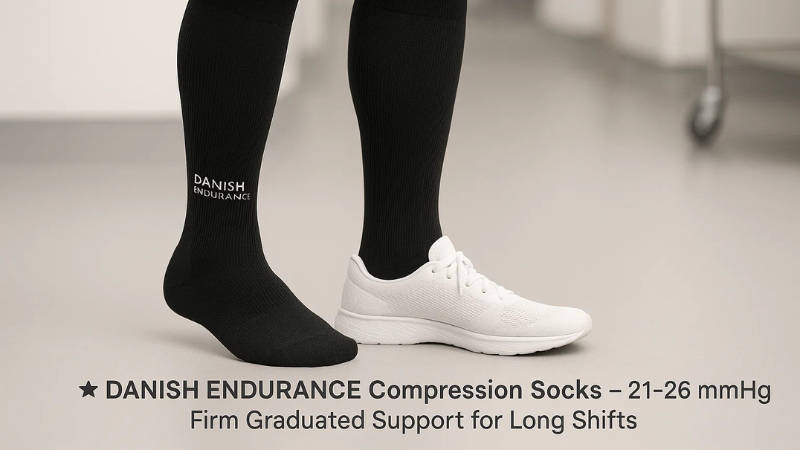
- Graduated compression model (~21-26 mmHg variant)
- Durable, breathable fabric with anti-bacterial yarns (brand-specified)
- Good size range (EU size chart provided) with multiple pack options
- Long cuff length to cover full calf — beneficial for full leg coverage during long shifts
These socks are crafted with durable, breathable materials and anti-bacterial yarns (per the brand’s description) to handle both performance and daily wear. Users report long-term durability; for example, one user wrote about wearing them daily and never getting a hole.
Given the demands of nursing — lots of walking, standing, occasional quick sprints down the corridor — the combination of support and durability makes them a strong contender. The slightly higher compression level means they’re particularly suited if you experience moderate leg fatigue or swelling by shift end.
- Strong support for long hours on feet
- Excellent durability reported by users (“no holes”, long-term use)
- Breathable and comfortable materials make them suitable for demanding shifts
- Full-calf coverage — helps under scrubs or nursing uniforms
- Higher compression may feel tight for beginners or those unused to compression socks
- Brand sizing uses EU sizes — may require careful attention to convert for US sizes
- Some users found the sizing “hard to judge” when ordering online.
You will find the necessary white shoes on the best white shoes for nurses.
8. Double Couple 7 Pairs Copper Compression Socks (20-30 mmHg)
Rating: 8.9/10If you’re tackling long 12-hour nursing shifts and want both value and support, the Double Couple Copper Compression Socks bring a lot to the table. With a 20-30 mmHg graduated compression rating, they’re firm enough to help reduce leg fatigue and swelling.
The copper-infused fabric adds a touch of freshness, which is handy when you have back-to-back shifts and want your feet to feel less tired and more energized.
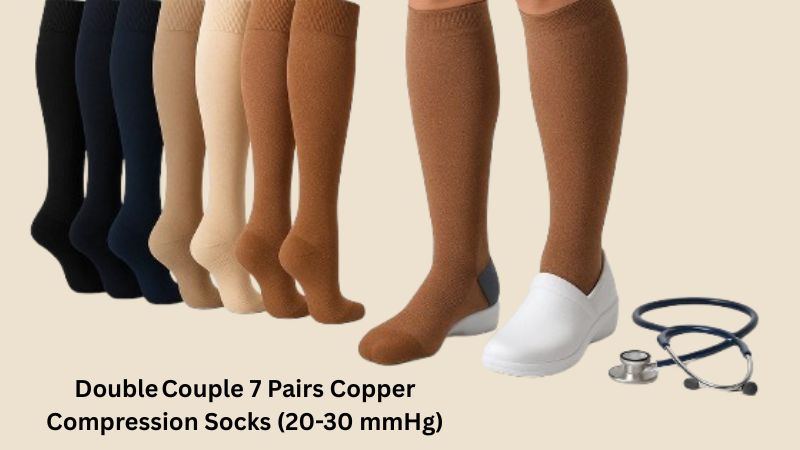
- Compression level: 20-30 mmHg (for solid support)
- Copper-infused fibers: aid odor control + enhanced circulation feel
- Graduated compression design: tighter at ankle, looser at calf
- Knee-high length for full lower-leg coverage
- Multi-pair pack (7 pairs) for daily/shift use
- Reinforced ankle/foot weave for durability
These come in a 7-pair bundle, meaning you’ll have plenty of socks to rotate through the week — a definite bonus for busy nurses. The reinforced ankle and compact weave around the foot provide extra support, especially in high-stress areas like the sole and ankle.
The knee-high design gives full calf coverage, so you get consistent support up the leg rather than just around the ankle—helpful when you’re standing, walking, or moving patients for hours.
The fact that you get multiple pairs in one pack means you can wash some while wearing others, keeping your rotation fresh. As one description notes: “true graduated compression… to support your legs, reduce fatigue, soreness and prevent injuries.
- Excellent value: 7 pairs allow for rotation and daily use
- Copper-infused fabric adds an extra layer of benefit (odor control, freshness)
- Full calf support with good compression — great for long shifts
- Strong build and reinforced areas make it suit frequent wear
- Firm compression might feel too intense for beginners or those unaccustomed to this level
- Design/style may be basic — fewer fancy color options compared to premium brands
- Sizing must be checked carefully — tighter fit means correct size is important to comfort
9. Sockwell Circulator Moderate Graduated Compression Socks
Rating: 8.7/10The Sockwell Circulator socks provide a moderate compression level (15-20 mmHg), making them especially suitable for nurses. Users report that the socks stay up well, fit snugly around the arch, and help manage day-long standing without excessive tightening.
These socks are built with a premium fabric blend – including merino wool, bamboo rayon, stretch nylon, and spandex – offering breathable, moisture-wicking properties and a comfortable foot environment. The design incorporates arch support and a seamless toe closure.
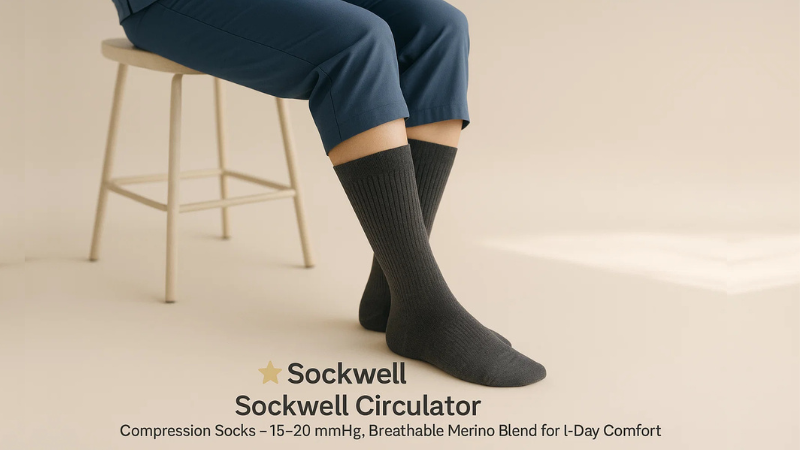
- Moderate graduated compression (15-20 mmHg)
- Premium fabric blend: merino wool, bamboo rayon, stretch nylon, spandex
- Arch support and seamless toe design for added comfort
- Breathable, moisture-wicking material suitable for extended standing
- Wide variety of styles and patterns for professional or personal preference
Since many nurses undergo 12-hour shifts, comfort and durability are essential. Many reviewers who stood 12–13 hours a day reported that these socks helped reduce swelling and fatigue in the lower legs. The moderate compression allows for comfort without feeling overly tight.
- Balanced compression that supports without being too tight — ideal for 12-hour shifts
- High-quality materials that reduce odor and improve comfort
- Arch support and design features that contribute to standing/walking all day
- Many style options — great if your uniform allows some creativity
- Compression is moderate — if you experience severe leg fatigue, swelling, or medical issues, you may need a stronger (20-30 mmHg) model
- Premium materials and brands may cost more than basic compression socks
- Wide calf or very large leg sizes might require careful checking for the best fit
10. NEENCA Medical Compression Socks for Women & Men Circulation
Rating: 9.0/10The NEENCA Medical Compression Socks are designed to provide 20–30 mmHg graduated compression and target users who stand for extended periods—such as nurses, flight staff, pregnant individuals, or travelers.
According to user feedback, they offer a snug fit, decent support, and all-day wear comfort. For example: “I can wear these all day and they are comfortable and they keep the swelling away while on my feet all day.”
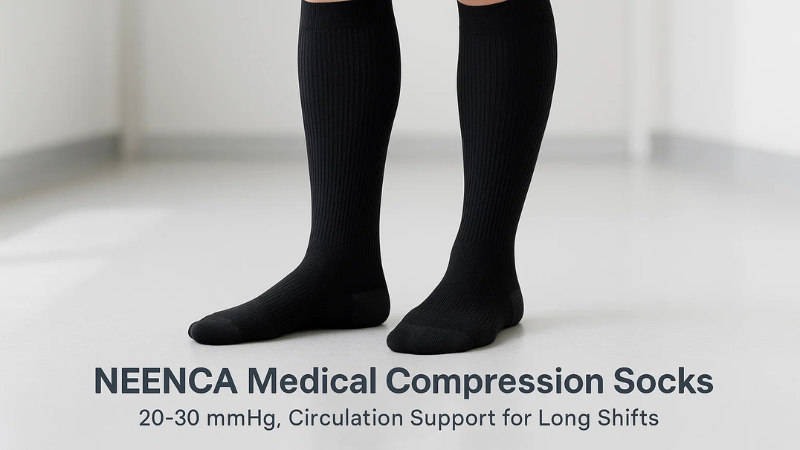
- 20–30 mmHg graduated compression (ankle tighter, loosens toward calf)
- Moisture-wicking, breathable fabric blend
- Double-stitched seams & reinforced heel and toe areas
- Available in several sizes & unisex (women & men)
- Suitable for all-day wear, travel, and swelling prevention
For those working 12-hour nursing shifts, the combination of compression support and moisture-wicking fabric appear beneficial: reviewers note improved circulation and less leg fatigue after long hours of standing or walking. However, some users say the compression could feel too tight around the calf, or that they had to size up for comfort.
Overall, the NEENCA socks offer a strong value proposition for nurses seeking reliable support without going into premium price tiers.
- Good compression level for long standing shifts
- Comfortable fit and breathable material, well suited for warm work environments
- Solid value compared to some premium compression sock brands
- Compression may feel tight for wider calves or first-time users
- Some users report less visible cushioning compared to socks marketed for impact-absorption
- Sizing clarity may be a bit less exact; users advise checking measurements carefully before purchase
Buyer’s Guide: How to Choose the Best Compression Socks for Nurses
Let’s be honest…
After standing, walking, and hustling through 12-hour shifts, it’s no surprise that nurses often deal with tired, swollen legs and sore feet. That’s exactly why finding the right pair of compression socks isn’t just about comfort — it’s about protecting your circulation, improving recovery, and keeping you moving with less pain.
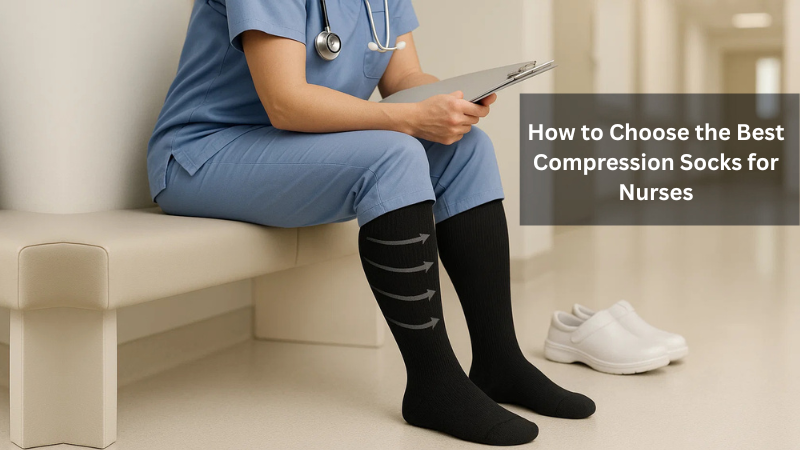
1. Know Your Compression Level
Compression socks come in different pressure levels, usually measured in mmHg (millimeters of mercury) — just like blood pressure.
Here’s a quick guide to what those numbers mean:
- 8–15 mmHg (Light Support):
Great for beginners or anyone who wants mild everyday comfort. - 15–20 mmHg (Moderate Compression):
Ideal for most nurses — helps with mild swelling, fatigue, and prevention of varicose veins during long shifts. - 20–30 mmHg (Firm Compression):
Perfect for those who already experience noticeable swelling, aching, or varicose veins after work. - 30–40 mmHg (Medical-Grade):
Recommended only under medical advice for severe circulation issues.
If you’re new to compression socks, start light to moderate (15–20 mmHg). Once your legs adjust, you can move up to firmer support if needed.
2. Choose the Right Fit and Size
Fit matters — a lot. Socks that are too tight can cut off circulation, and ones that are too loose won’t give proper support.
To get the right fit:
- Measure your calf and ankle circumference before buying.
- Always check the brand’s size chart — every company’s sizing is slightly different.
- If you have wide calves, look for “wide-calf” or “plus-size” versions to ensure comfort without pinching.
Remember: the best compression socks should feel snug and supportive, not painfully tight.
3. Pick the Right Material
Material affects everything — from how your socks feel to how long they last.
Here are your top options:
- Nylon/Spandex Blends: Smooth, stretchy, and durable. Most medical or athletic-grade socks use these.
- Merino Wool: Great for moisture control, temperature regulation, and odor resistance — perfect if your feet tend to sweat.
- Cotton or Bamboo: Soft and breathable, though not always as firm in compression.
If you’re on your feet for hours, breathable and moisture-wicking fabrics will keep your legs feeling fresh and dry.
4. Consider the Compression Design
Not all compression socks are the same — pay attention to the design style:
- Graduated Compression:
Tighter at the ankle and gradually looser toward the calf — the most effective type for improving blood flow and reducing fatigue. - Uniform Compression:
Same pressure all the way up the leg — less common, but good for general comfort.
For nurses, graduated compression is almost always the best choice. It helps push blood back up the legs, preventing swelling and heaviness during long shifts.
5. Look for Durability and Ease of Use
You’ll likely wear your compression socks multiple times a week — maybe daily — so durability matters.
- Check if they have reinforced heels and toes, which prevent holes and wear.
- Look for easy-stretch materials if you struggle to pull them on and off.
- If possible, get multiple pairs so you can rotate them throughout the week.
Bonus tip: wash them gently and air dry to keep their elasticity for longer.
6. Think About Style and Comfort Features
Just because compression socks are functional doesn’t mean they can’t be stylish! Many brands now offer fun colors, patterns, and designs — perfect for brightening up your scrubs.
Other comfort features to look for:
- Seamless toes to avoid irritation.
- Arch support bands for extra comfort during long walks.
- Wide cuffs to prevent rolling or digging into the skin.
The right features can make a big difference in how they feel after 10+ hours of standing.
7. Don’t Forget Your Specific Needs
Every nurse’s body is different. Here’s how to match your socks to your needs:
- For swelling or varicose veins: Go for 20–30 mmHg compression.
- For general fatigue prevention: Choose 15–20 mmHg.
- For wide calves or plus-size legs: Select wide-calf models.
- For hot environments: Pick moisture-wicking or breathable mesh fabrics.
- For cold hospital wards: Wool or thermal compression socks work wonders.
Knowing your body and work environment helps you choose smarter — not just trendier.
8. Budget vs. Value
Compression socks come in all price ranges — from budget-friendly multi-packs to premium single pairs.
Here’s the thing: price doesn’t always equal quality.
Affordable socks can still deliver great comfort and compression, while premium ones often last longer and feel softer. If you’re testing what works for you, start mid-range — then invest in higher-quality pairs once you know your preferred fit and feel.
So,
Choosing the best compression socks for nursing shifts isn’t about chasing the most expensive option — it’s about finding the right balance between comfort, support, and durability.
When your legs feel lighter, your energy lasts longer — and that makes a big difference in how you show up for your patients and yourself.
So, take your time, pick wisely, and let your socks work as hard as you do.
Final Thoughts
After hours of standing, rushing between patients, and barely getting a break, your legs and feet take a serious beating. That’s why choosing the right compression socks isn’t a luxury — it’s self-care that helps you feel better, move easier, and recover faster.
We’ve reviewed the top-rated options trusted by nurses, and while all of them offer solid benefits, one pair truly stands out when it comes to overall comfort, durability, and support.
FAQs
1. Why do nurses need compression socks?
Nurses spend long hours standing, walking, and moving patients — which causes blood to pool in the lower legs. Compression socks help improve circulation, reduce swelling, and prevent fatigue or varicose veins. They’re like a gentle hug for your legs, keeping your energy levels steady from the first hour to the twelfth.
2. What level of compression is best for nurses?
Most nurses do best with 15–20 mmHg (moderate) or 20–30 mmHg (firm) compression.
- Choose 15–20 mmHg if you’re new to compression socks or want general comfort and light support.
- Choose 20–30 mmHg if you experience noticeable swelling, aching, or varicose veins after shifts.
3. Can I wear compression socks all day during a 12-hour shift?
Absolutely! In fact, that’s when they’re most effective. Good-quality compression socks are designed for all-day wear, helping your legs stay light and supported. Just make sure they fit correctly and aren’t too tight at the top — that’s the key to comfort and proper circulation.
4. Should I wear compression socks every day?
Yes — especially if you’re on your feet daily. Wearing them regularly can prevent long-term circulation issues, reduce leg fatigue, and keep swelling under control. Think of them as part of your uniform, just like your scrubs or stethoscope.
5. What’s the difference between compression socks and regular socks?
Regular socks just cover your feet; compression socks do real work. They apply gentle pressure that helps push blood back up your legs, reducing strain on your veins. That’s why they’re essential for jobs that involve long periods of standing, like nursing.
6. How tight should compression socks feel?
They should feel snug but not painful. You’ll notice gentle pressure at the ankle that eases up as it goes up your calf — that’s what “graduated compression” means. If they cut off circulation or leave deep marks, they’re too tight; try a different size or compression level.
7. Are compression socks good for varicose veins or swelling?
Yes — they’re one of the most recommended non-medical solutions for varicose veins, spider veins, and edema (swelling). By improving blood flow, they prevent blood from pooling and help veins work more efficiently.
8. Can men wear compression socks made for women?
Of course! Compression socks are unisex in function — just focus on the size and compression level that fits your legs. Many brands now label their products for both men and women.
9. How many pairs of compression socks do nurses need?
If you work full-time, aim for at least 5–7 pairs so you can rotate them throughout the week. Having a fresh pair every shift not only improves comfort but also extends the life of each sock.
10. How do I wash and care for my compression socks?
Always hand wash or use a gentle machine cycle with cold water, and air dry them flat. Avoid using hot dryers — heat can break down the elastic fibers that give your socks their compression power.

Leave a Reply